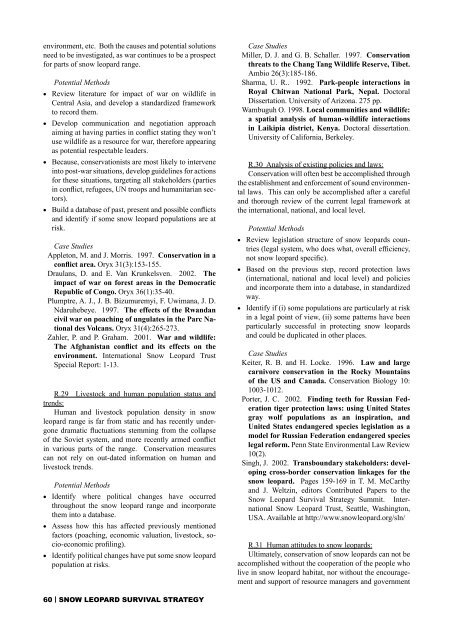Snow Leopard Survival Strategy - Panthera
Snow Leopard Survival Strategy - Panthera
Snow Leopard Survival Strategy - Panthera
You also want an ePaper? Increase the reach of your titles
YUMPU automatically turns print PDFs into web optimized ePapers that Google loves.
environment, etc. Both the causes and potential solutions<br />
need to be investigated, as war continues to be a prospect<br />
for parts of snow leopard range.<br />
Potential Methods<br />
• Review literature for impact of war on wildlife in<br />
Central Asia, and develop a standardized framework<br />
to record them.<br />
• Develop communication and negotiation approach<br />
aiming at having parties in conflict stating they won’t<br />
use wildlife as a resource for war, therefore appearing<br />
as potential respectable leaders.<br />
• Because, conservationists are most likely to intervene<br />
into post-war situations, develop guidelines for actions<br />
for these situations, targeting all stakeholders (parties<br />
in conflict, refugees, UN troops and humanitarian sectors).<br />
• Build a database of past, present and possible conflicts<br />
and identify if some snow leopard populations are at<br />
risk.<br />
Case Studies<br />
Appleton, M. and J. Morris. 1997. Conservation in a<br />
conflict area. Oryx 31(3):153-155.<br />
Draulans, D. and E. Van Krunkelsven. 2002. The<br />
impact of war on forest areas in the Democratic<br />
Republic of Congo. Oryx 36(1):35-40.<br />
Plumptre, A. J., J. B. Bizumuremyi, F. Uwimana, J. D.<br />
Ndaruhebeye. 1997. The effects of the Rwandan<br />
civil war on poaching of ungulates in the Parc National<br />
des Volcans. Oryx 31(4):265-273.<br />
Zahler, P. and P. Graham. 2001. War and wildlife:<br />
The Afghanistan conflict and its effects on the<br />
environment. International <strong>Snow</strong> <strong>Leopard</strong> Trust<br />
Special Report: 1-13.<br />
R.29 Livestock and human population status and<br />
trends:<br />
Human and livestock population density in snow<br />
leopard range is far from static and has recently undergone<br />
dramatic fluctuations stemming from the collapse<br />
of the Soviet system, and more recently armed conflict<br />
in various parts of the range. Conservation measures<br />
can not rely on out-dated information on human and<br />
livestock trends.<br />
Potential Methods<br />
• Identify where political changes have occurred<br />
throughout the snow leopard range and incorporate<br />
them into a database.<br />
• Assess how this has affected previously mentioned<br />
factors (poaching, economic valuation, livestock, socio-economic<br />
profiling).<br />
• Identify political changes have put some snow leopard<br />
population at risks.<br />
Case Studies<br />
Miller, D. J. and G. B. Schaller. 1997. Conservation<br />
threats to the Chang Tang Wildlife Reserve, Tibet.<br />
Ambio 26(3):185-186.<br />
Sharma, U. R.. 1992. Park-people interactions in<br />
Royal Chitwan National Park, Nepal. Doctoral<br />
Dissertation. University of Arizona. 275 pp.<br />
Wambuguh O. 1998. Local communities and wildlife:<br />
a spatial analysis of human-wildlife interactions<br />
in Laikipia district, Kenya. Doctoral dissertation.<br />
University of California, Berkeley.<br />
R.30 Analysis of existing policies and laws:<br />
Conservation will often best be accomplished through<br />
the establishment and enforcement of sound environmental<br />
laws. This can only be accomplished after a careful<br />
and thorough review of the current legal framework at<br />
the international, national, and local level.<br />
Potential Methods<br />
• Review legislation structure of snow leopards countries<br />
(legal system, who does what, overall efficiency,<br />
not snow leopard specific).<br />
• Based on the previous step, record protection laws<br />
(international, national and local level) and policies<br />
and incorporate them into a database, in standardized<br />
way.<br />
• Identify if (i) some populations are particularly at risk<br />
in a legal point of view, (ii) some patterns have been<br />
particularly successful in protecting snow leopards<br />
and could be duplicated in other places.<br />
Case Studies<br />
Keiter, R. B. and H. Locke. 1996. Law and large<br />
carnivore conservation in the Rocky Mountains<br />
of the US and Canada. Conservation Biology 10:<br />
1003-1012.<br />
Porter, J. C. 2002. Finding teeth for Russian Federation<br />
tiger protection laws: using United States<br />
gray wolf populations as an inspiration, and<br />
United States endangered species legislation as a<br />
model for Russian Federation endangered species<br />
legal reform. Penn State Environmental Law Review<br />
10(2).<br />
Singh, J. 2002. Transboundary stakeholders: developing<br />
cross-border conservation linkages for the<br />
snow leopard. Pages 159-169 in T. M. McCarthy<br />
and J. Weltzin, editors Contributed Papers to the<br />
<strong>Snow</strong> <strong>Leopard</strong> <strong>Survival</strong> <strong>Strategy</strong> Summit. International<br />
<strong>Snow</strong> <strong>Leopard</strong> Trust, Seattle, Washington,<br />
USA. Available at http://www.snowleopard.org/sln/<br />
R.31 Human attitudes to snow leopards:<br />
Ultimately, conservation of snow leopards can not be<br />
accomplished without the cooperation of the people who<br />
live in snow leopard habitat, nor without the encouragement<br />
and support of resource managers and government<br />
60 | SNOW LEOPARD SURVIVAL STRATEGY
















